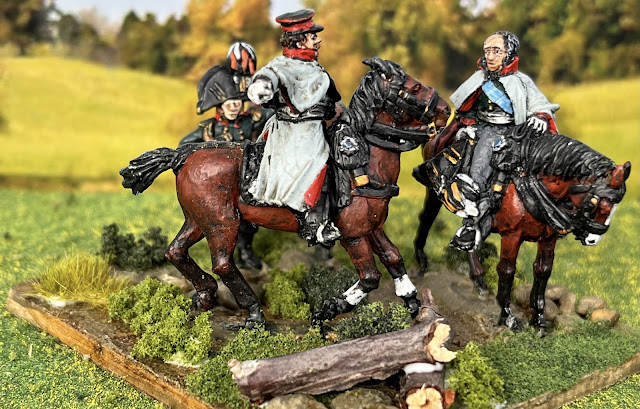When the Kingdom of Hanover was annexed by Prussia at the end of the Austro-Prussian War, its army was absorbed into the Prussian Army, forming four new regiments:
- 73rd, Hanoverian Fusilier Regiment
- 74th, 1st Hanoverian Infantry Regiment
- 77th, 2nd Hanoverian Infantry Regiment
- 79th, 3rd Hanoverian Infantry Regiment
This week’s unit represents First Battalion, 2nd Hanoverian Infantry Regiment that served in VII Corps in 1870. In its first action in that war, at Spicheren on 6 August, the regiment was heavily engaged on the right of the battle line in the Stiring Copse and the Fusilier battalion (supported by a company of the 2nd Battalion) stormed the homesteads at the foot of the Spicheren Heights. In these hard fought actions the regiment suffered losses of 628 (131 killed, 438 wounded and 59 missing), around 20% of their effective strength. The regiment was lightly engaged in the actions of Borny and Gravelotte that followed.
 |
| The attack of the Fusilier Battalion, 77th Regiment against the Baraque Mouton and the Golden Bremm at Spicheren, 6 August 1870 |







I like how your Prussian infantry posed with rifle at the trail mirror the illustration from Spicheren.
ReplyDeleteMany of the images of the FPW show troops advancing at the trail. The way that these figures are designed mean that even though the pose is similar, head variant and positioning can be varied.
DeleteWhenever I think of Hanoverians I always expect to see them in red coats, so it is interesting to see these and learn how they were absorbed into the Prussian army. Nice work on the Russian generals' bases too, Mark.
ReplyDeleteAnd the Hanoverians handed out the only defeat for the Prussians in 1866 at Langelsalza, but were then boxed in and forced to surrender a few days later. Some of the other minor states retained references to their past history, the 17th Brunswick Hussars, for example, still bore the honours of “Peninsula, Sicily, Waterloo” on a banderole to mark their British service in the Napoleonic Wars.
DeleteGreat blog
ReplyDeleteThank you
DeleteA really smart looking unit. The way you’ve done the flag looks especially realistic. You really crank out the miniatures. 😀
ReplyDeleteI like to try make the flags “flow”…I have never been a fan of them just sticking straight off the pole. These days I work to a painting schedule of six foot figures, three mounted or one gun set (of a gun and four crew) per night. It is a comfortable pace for me and while it is a very structured approach it allows me to not only meet deadlines for special events (not that there have been many since the plague struck), but also lets me better manage purchases/impulses, avoiding having to explain why boxes of metal and plastic keep appearing on the doorstep.
DeleteHow many Prussian units is that now Mark? They do look good in their almost black uniforms. I agree about flags, totally straight, rigid ones only work with old school high gloss figures all of an identical pose on bright green bases!
ReplyDeleteTwenty down, five to go! If you are cheap like me then folding the flags also disguises the imperfections in the printing.
DeleteAnother very smart unit! And the work on the Russian command bases really enhances what was already a fine job on the figures. Your 'daily' output exceeds my week. Nice to see the collections take place. Your technique on flag handling made me smile.
ReplyDeleteThanks Joe. My daily production rate is pretty low these days - back in the 1980’s I managed 28 FPW Prussians or about half that of Napoleonics in a day!
DeleteExcellent brushwork Mark.
ReplyDeleteThanks Ray. The project is crawling towards it’s conclusion…well the infantry part anyway.
DeleteGreat work there Mark and I must admit that I love those B&W illustrations of the battles of this period as they are not only lovely to look at, but give one a great sense of the battlefields too.
ReplyDeleteThanks Steve. From what I can see from maps and photographs that image is pretty accurate depiction of the terrain too. Often artistic license takes over and the opposing sides are represented at unrealistic distances apart.
DeleteGreat looking Hanoverians/Prussians! I thought there was a Hanoverian unit that had Gibraltar cuff sign that they carried up until the end of the great war.
ReplyDeleteBest Iain
Thanks Iain. Hopefully that unit is not one of the two that I am doing…I don’t fancy converting the cuffs of 72 figures!
Delete